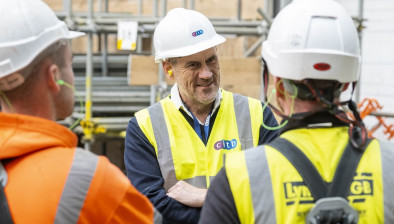Jo Gilroy: Zero carbon construction site - unlocking the potential of hydrogen

Jo Gilroy
Jo Gilroy, group director of sustainability at Balfour Beatty, discusses the benefits and pitfalls of introducing hydrogen solutions on site at the company’s zero carbon construction site at the Royal Botanic Garden in Edinburgh.
It’s been a few months since we last updated on our progress towards the Zero Carbon Construction Site of the future at the Royal Botanic Garden, Edinburgh – and believe me, there is a lot to tell you about.
Firstly, let me refresh your memory. Our Zero Carbon Construction Site is where we are testing ground-breaking solutions and approaches to cut emissions and embrace cleaner practices.
Following the publication of our fuel hierarchy – which looks to educate people on the most appropriate, sustainable energy sources for plant, equipment, vehicles, and buildings - our most recent focus has been on introducing hydrogen alternatives on site.
Hydrogen has enormous potential to rapidly decarbonise our industry. It’s abundant, produces clean energy without CO2 emissions, and can be generated using low-carbon technologies. From clean energy storage to low-emission fuel cells and sustainable building materials, hydrogen offers a range of possibilities.
But it’s not all plain sailing. The clean hydrogen industry is still very much in its infancy, and there are a number of large obstacles standing in the way, including availability, cost, and infrastructure limitations.
For example, no matter how many ways we tried to make it work, the space requirements and footprint of a hydrogen setup, including the need for large storage tanks, made using hydrogen unworkable on the compact, Royal Botanic Garden site in Edinburgh.
Whilst disappointing (without question), we recognise that innovation often demands resilience and acceptance of setbacks. We will now take our learnings to make changes moving forward and set aside space for hydrogen storage areas on site during the bid phase.
We didn’t let this minor hiccup dampen our spirits and as our understanding of hydrogen improves, we’re exploring how it can be used on other projects which have more available space.
This includes a number of other projects where logistics are less challenging, not least at Balfour Beatty VINCI’s HS2 site near Birmingham, where we have hydrogen generation powering a large temporary accommodation building.
You might also have heard the news this morning, that we’ve become the first construction company in the UK to secure funding from the Scottish Government’s Emerging Energies Technology Fund, to retrofit four carbon intensive vehicles to run off both hydrogen and diesel – otherwise known as dual fuel.
Once the retrofit is complete, we’ll be trialling them on our Connect Roads M77/Glasgow Southern Orbital project. We’re expecting to see a 40% reduction in carbon emissions from each of the four retrofitted vehicles, with the aim of providing a blueprint for the conversion of all Balfour Beatty owned fleet in the future.
So, while our efforts to incorporate hydrogen on site at the Royal Botanic Gardens in Edinburgh ultimately didn’t work, the knowledge we gained is invaluable and will serve as a compass guiding our future transition to hydrogen fuels.
We’re not just talking the talk; we’re making sure that our business is at the forefront of the hydrogen revolution in the construction and infrastructure sector.

















